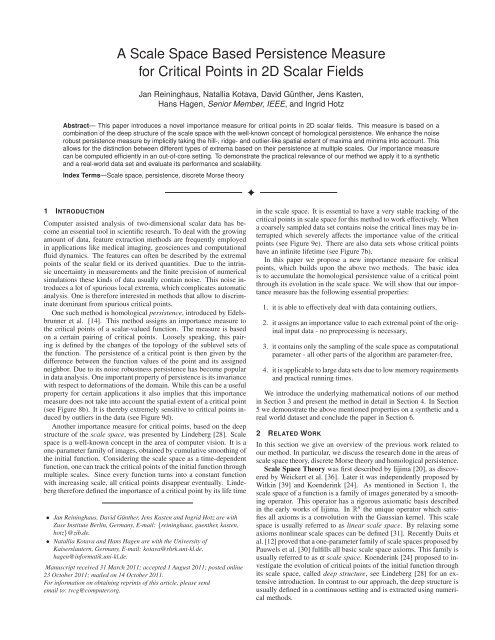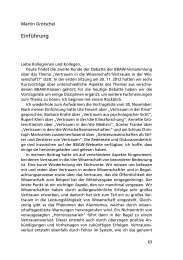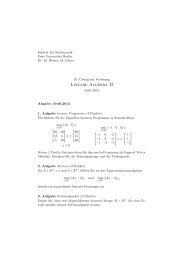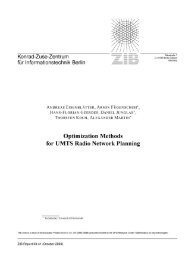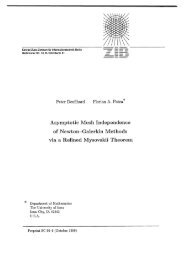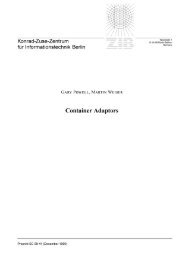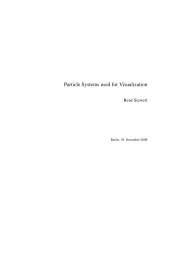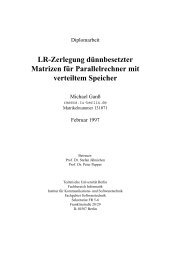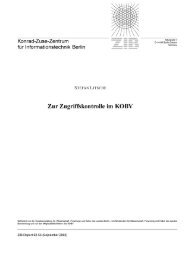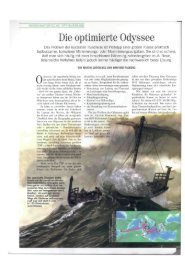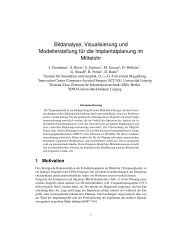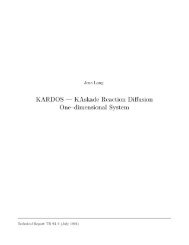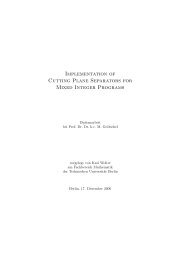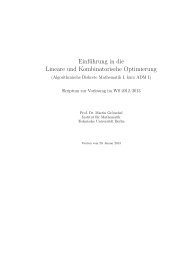A Scale Space Based Persistence Measure for Critical Points in 2D ...
A Scale Space Based Persistence Measure for Critical Points in 2D ...
A Scale Space Based Persistence Measure for Critical Points in 2D ...
You also want an ePaper? Increase the reach of your titles
YUMPU automatically turns print PDFs into web optimized ePapers that Google loves.
A <strong>Scale</strong> <strong>Space</strong> <strong>Based</strong> <strong>Persistence</strong> <strong>Measure</strong><br />
<strong>for</strong> <strong>Critical</strong> <strong>Po<strong>in</strong>ts</strong> <strong>in</strong> <strong>2D</strong> Scalar Fields<br />
Jan Re<strong>in</strong><strong>in</strong>ghaus, Natallia Kotava, David Günther, Jens Kasten,<br />
Hans Hagen, Senior Member, IEEE, and Ingrid Hotz<br />
Abstract— This paper <strong>in</strong>troduces a novel importance measure <strong>for</strong> critical po<strong>in</strong>ts <strong>in</strong> <strong>2D</strong> scalar fields. This measure is based on a<br />
comb<strong>in</strong>ation of the deep structure of the scale space with the well-known concept of homological persistence. We enhance the noise<br />
robust persistence measure by implicitly tak<strong>in</strong>g the hill-, ridge- and outlier-like spatial extent of maxima and m<strong>in</strong>ima <strong>in</strong>to account. This<br />
allows <strong>for</strong> the dist<strong>in</strong>ction between different types of extrema based on their persistence at multiple scales. Our importance measure<br />
can be computed efficiently <strong>in</strong> an out-of-core sett<strong>in</strong>g. To demonstrate the practical relevance of our method we apply it to a synthetic<br />
and a real-world data set and evaluate its per<strong>for</strong>mance and scalability.<br />
Index Terms—<strong>Scale</strong> space, persistence, discrete Morse theory<br />
1 INTRODUCTION<br />
Computer assisted analysis of two-dimensional scalar data has become<br />
an essential tool <strong>in</strong> scientific research. To deal with the grow<strong>in</strong>g<br />
amount of data, feature extraction methods are frequently employed<br />
<strong>in</strong> applications like medical imag<strong>in</strong>g, geosciences and computational<br />
fluid dynamics. The features can often be described by the extremal<br />
po<strong>in</strong>ts of the scalar field or its derived quantities. Due to the <strong>in</strong>tr<strong>in</strong>sic<br />
uncerta<strong>in</strong>ty <strong>in</strong> measurements and the f<strong>in</strong>ite precision of numerical<br />
simulations these k<strong>in</strong>ds of data usually conta<strong>in</strong> noise. This noise <strong>in</strong>troduces<br />
a lot of spurious local extrema, which complicates automatic<br />
analysis. One is there<strong>for</strong>e <strong>in</strong>terested <strong>in</strong> methods that allow to discrim<strong>in</strong>ate<br />
dom<strong>in</strong>ant from spurious critical po<strong>in</strong>ts.<br />
One such method is homological persistence, <strong>in</strong>troduced by Edelsbrunner<br />
et al. [14]. This method assigns an importance measure to<br />
the critical po<strong>in</strong>ts of a scalar-valued function. The measure is based<br />
on a certa<strong>in</strong> pair<strong>in</strong>g of critical po<strong>in</strong>ts. Loosely speak<strong>in</strong>g, this pair<strong>in</strong>g<br />
is def<strong>in</strong>ed by the changes of the topology of the sublevel sets of<br />
the function. The persistence of a critical po<strong>in</strong>t is then given by the<br />
difference between the function values of the po<strong>in</strong>t and its assigned<br />
neighbor. Due to its noise robustness persistence has become popular<br />
<strong>in</strong> data analysis. One important property of persistence is its <strong>in</strong>variance<br />
with respect to de<strong>for</strong>mations of the doma<strong>in</strong>. While this can be a useful<br />
property <strong>for</strong> certa<strong>in</strong> applications it also implies that this importance<br />
measure does not take <strong>in</strong>to account the spatial extent of a critical po<strong>in</strong>t<br />
(see Figure 8b). It is thereby extremely sensitive to critical po<strong>in</strong>ts <strong>in</strong>duced<br />
by outliers <strong>in</strong> the data (see Figure 9d).<br />
Another importance measure <strong>for</strong> critical po<strong>in</strong>ts, based on the deep<br />
structure of the scale space, was presented by L<strong>in</strong>deberg [28]. <strong>Scale</strong><br />
space is a well-known concept <strong>in</strong> the area of computer vision. It is a<br />
one-parameter family of images, obta<strong>in</strong>ed by cumulative smooth<strong>in</strong>g of<br />
the <strong>in</strong>itial function. Consider<strong>in</strong>g the scale space as a time-dependent<br />
function, one can track the critical po<strong>in</strong>ts of the <strong>in</strong>itial function through<br />
multiple scales. S<strong>in</strong>ce every function turns <strong>in</strong>to a constant function<br />
with <strong>in</strong>creas<strong>in</strong>g scale, all critical po<strong>in</strong>ts disappear eventually. L<strong>in</strong>deberg<br />
there<strong>for</strong>e def<strong>in</strong>ed the importance of a critical po<strong>in</strong>t by its life time<br />
• Jan Re<strong>in</strong><strong>in</strong>ghaus, David Günther, Jens Kasten and Ingrid Hotz are with<br />
Zuse Institute Berl<strong>in</strong>, Germany, E-mail: {re<strong>in</strong><strong>in</strong>ghaus, guenther, kasten,<br />
hotz}@zib.de.<br />
• Natallia Kotava and Hans Hagen are with the University of<br />
Kaiserslautern, Germany, E-mail: kotava@rhrk.uni-kl.de,<br />
hagen@<strong>in</strong><strong>for</strong>matik.uni-kl.de.<br />
Manuscript received 31 March 2011; accepted 1 August 2011; posted onl<strong>in</strong>e<br />
23 October 2011; mailed on 14 October 2011.<br />
For <strong>in</strong><strong>for</strong>mation on obta<strong>in</strong><strong>in</strong>g repr<strong>in</strong>ts of this article, please send<br />
email to: tvcg@computer.org.<br />
<strong>in</strong> the scale space. It is essential to have a very stable track<strong>in</strong>g of the<br />
critical po<strong>in</strong>ts <strong>in</strong> scale space <strong>for</strong> this method to work effectively. When<br />
a coarsely sampled data set conta<strong>in</strong>s noise the critical l<strong>in</strong>es may be <strong>in</strong>terrupted<br />
which severely affects the importance value of the critical<br />
po<strong>in</strong>ts (see Figure 9e). There are also data sets whose critical po<strong>in</strong>ts<br />
have an <strong>in</strong>f<strong>in</strong>ite lifetime (see Figure 7b).<br />
In this paper we propose a new importance measure <strong>for</strong> critical<br />
po<strong>in</strong>ts, which builds upon the above two methods. The basic idea<br />
is to accumulate the homological persistence value of a critical po<strong>in</strong>t<br />
through its evolution <strong>in</strong> the scale space. We will show that our importance<br />
measure has the follow<strong>in</strong>g essential properties:<br />
1. it is able to effectively deal with data conta<strong>in</strong><strong>in</strong>g outliers,<br />
2. it assigns an importance value to each extremal po<strong>in</strong>t of the orig<strong>in</strong>al<br />
<strong>in</strong>put data - no preprocess<strong>in</strong>g is necessary,<br />
3. it conta<strong>in</strong>s only the sampl<strong>in</strong>g of the scale space as computational<br />
parameter - all other parts of the algorithm are parameter-free,<br />
4. it is applicable to large data sets due to low memory requirements<br />
and practical runn<strong>in</strong>g times.<br />
We <strong>in</strong>troduce the underly<strong>in</strong>g mathematical notions of our method<br />
<strong>in</strong> Section 3 and present the method <strong>in</strong> detail <strong>in</strong> Section 4. In Section<br />
5 we demonstrate the above mentioned properties on a synthetic and a<br />
real world dataset and conclude the paper <strong>in</strong> Section 6.<br />
2 RELATED WORK<br />
In this section we give an overview of the previous work related to<br />
our method. In particular, we discuss the research done <strong>in</strong> the areas of<br />
scale space theory, discrete Morse theory and homological persistence.<br />
<strong>Scale</strong> <strong>Space</strong> Theory was first described by Iijima [20], as discovered<br />
by Weickert et al. [36]. Later it was <strong>in</strong>dependently proposed by<br />
Witk<strong>in</strong> [39] and Koender<strong>in</strong>k [24]. As mentioned <strong>in</strong> Section 1, the<br />
scale space of a function is a family of images generated by a smooth<strong>in</strong>g<br />
operator. This operator has a rigorous axiomatic basis described<br />
<strong>in</strong> the early works of Iijima. In R n the unique operator which satisfies<br />
all axioms is a convolution with the Gaussian kernel. This scale<br />
space is usually referred to as l<strong>in</strong>ear scale space. By relax<strong>in</strong>g some<br />
axioms nonl<strong>in</strong>ear scale spaces can be def<strong>in</strong>ed [31]. Recently Duits et<br />
al. [12] proved that a one-parameter family of scale spaces proposed by<br />
Pauwels et al. [30] fulfills all basic scale space axioms. This family is<br />
usually referred to as α scale space. Koender<strong>in</strong>k [24] proposed to <strong>in</strong>vestigate<br />
the evolution of critical po<strong>in</strong>ts of the <strong>in</strong>itial function through<br />
its scale space, called deep structure, see L<strong>in</strong>deberg [28] <strong>for</strong> an extensive<br />
<strong>in</strong>troduction. In contrast to our approach, the deep structure is<br />
usually def<strong>in</strong>ed <strong>in</strong> a cont<strong>in</strong>uous sett<strong>in</strong>g and is extracted us<strong>in</strong>g numerical<br />
methods.
[8] D. Cohen-Ste<strong>in</strong>er, H. Edelsbrunner, and D. Morozov. V<strong>in</strong>es and v<strong>in</strong>eyards<br />
by updat<strong>in</strong>g persistence <strong>in</strong> l<strong>in</strong>ear time. In Proceed<strong>in</strong>gs of the twentysecond<br />
annual symposium on Computational geometry, SCG ’06, pages<br />
119–126, New York, NY, USA, 2006. ACM.<br />
[9] C. Correa and K.-L. Ma. Size-based transfer functions: A new volume<br />
exploration technique. IEEE Transactions on Visualization and Computer<br />
Graphics, 14:1380–1387, 2008.<br />
[10] V. de Silva, D. Morozov, and M. Vejdemo-Johansson. Dualities <strong>in</strong> persistent<br />
(co)homology. Technical report, 2010.<br />
[11] R. Duits, M. Felsberg, L. Florack, and B. Platel. α <strong>Scale</strong> <strong>Space</strong>s on a<br />
Bounded Doma<strong>in</strong>. Lecture Notes <strong>in</strong> Computer Science, 2695:494–510,<br />
2003.<br />
[12] R. Duits, L. Florack, J. De Graaf, and B. Ter Haar Romeny. On the axioms<br />
of scale space theory. J. Math. Imag<strong>in</strong>g Vis., 20:267–298, May 2004.<br />
[13] H. Edelsbrunner and J. Harer. Computational Topology: An Introduction.<br />
American Mathematical Society, 2010.<br />
[14] H. Edelsbrunner, D. Letscher, and A. Zomorodian. Topological persistence<br />
and simplification. Discrete and Computational Geometry,<br />
28(4):511–533, 2002.<br />
[15] R. Forman. Morse theory <strong>for</strong> cell complexes. Advances <strong>in</strong> Mathematics,<br />
134:90–145, 1998.<br />
[16] P. Fros<strong>in</strong>i and C. Landi. Size theory as a topological tool <strong>for</strong> computer<br />
vision. Pattern Recognition and Image Analysis, 9:596–603, 1999.<br />
[17] A. Gyulassy, P.-T. Bremer, B. Hamann, and V. Pascucci. A practical approach<br />
to Morse-Smale complex computation: scalability and generality.<br />
IEEE Transactions on Visualization and Computer Graphics, 14:1619–<br />
1626, 2008.<br />
[18] A. Gyulassy, M. A. Ducha<strong>in</strong>eau, V. Natarajan, V. Pascucci, E. Br<strong>in</strong>ga,<br />
A. Higg<strong>in</strong>botham, and B. Hamann. Topologically clean distance fields.<br />
TVCG, 13(6):1432–1439, 2007.<br />
[19] A. Hatcher. Algebraic Topology. Cambridge University Press, Cambridge,<br />
U.K., 2002.<br />
[20] T. Iijima. Basic theory on normalization of a pattern (<strong>in</strong> case of typical<br />
one-dimensional pattern). Bullet<strong>in</strong> of Electrical Laboratory, 26:368–388,<br />
1962.<br />
[21] G. L. K<strong>in</strong>dlmann, R. S. J. Estepar, S. M. Smith, and C.-F. West<strong>in</strong>. Sampl<strong>in</strong>g<br />
and visualiz<strong>in</strong>g creases with scale-space particles. IEEE Transactions<br />
on Visualization and Computer Graphics, 15:1415–1424, 2009.<br />
[22] H. K<strong>in</strong>g, K. Knudson, and N. Mramor. Generat<strong>in</strong>g discrete Morse functions<br />
from po<strong>in</strong>t data. Experimental Mathematics, 14(4):435–444, 2005.<br />
[23] T. Kle<strong>in</strong> and T. Ertl. <strong>Scale</strong>-<strong>Space</strong> Track<strong>in</strong>g of <strong>Critical</strong> <strong>Po<strong>in</strong>ts</strong> <strong>in</strong> 3D Vector<br />
Fields. In H. Hauser, H. Hagen, and H. Theisel, editors, Mathematics and<br />
Visualization, Topology-<strong>Based</strong> Methods <strong>in</strong> Visualization (Proceed<strong>in</strong>gs of<br />
TopoInVis ’05), pages 35–49. Spr<strong>in</strong>ger, Berl<strong>in</strong> Heidelberg, 2007.<br />
[24] J. Koender<strong>in</strong>k. The structure of images. Biological Cybernetics, 50:363–<br />
370, 1984.<br />
[25] D. Laney, P. T. Bremer, A. Mascarenhas, P. Miller, and V. Pascucci. Understand<strong>in</strong>g<br />
the structure of the turbulent mix<strong>in</strong>g layer <strong>in</strong> hydrodynamic<br />
<strong>in</strong>stabilities. IEEE Transactions on Visualization and Computer Graphics,<br />
12(5):1053–1060, 2006.<br />
[26] T. Lew<strong>in</strong>er, H. Lopes, and G. Tavares. Applications of Forman’s discrete<br />
Morse theory to topology visualization and mesh compression. IEEE<br />
Transactions on Visualization and Computer Graphics, 10(5):499–508,<br />
2004.<br />
[27] L. M. Lifshitz and S. M. Pizer. A multiresolution hierarchical approach<br />
to image segmentation based on <strong>in</strong>tensity extrema. IEEE Transactions on<br />
Pattern Anaysis and Mach<strong>in</strong>e Intelligence, 12:529–540, June 1990.<br />
[28] T. L<strong>in</strong>deberg. <strong>Scale</strong>-<strong>Space</strong> Theory <strong>in</strong> Computer Vision. Kluwer Academic<br />
Publishers, 1994.<br />
[29] J. Milnor. Topology from the differentiable viewpo<strong>in</strong>t. Univ. Press Virg<strong>in</strong>ia,<br />
1965.<br />
[30] E. J. Pauwels, L. J. Van Gool, P. Fiddelaers, and T. Moons. An extended<br />
class of scale-<strong>in</strong>variant and recursive scale space filters. IEEE Trans.<br />
Pattern Anal. Mach. Intell., 17:691–701, July 1995.<br />
[31] P. Perona and J. Malik. <strong>Scale</strong>-space and edge detection us<strong>in</strong>g anisotropic<br />
diffusion. IEEE Transactions on Pattern Analysis and Mach<strong>in</strong>e Intelligence,<br />
12:629–639, 1990.<br />
[32] J. Re<strong>in</strong><strong>in</strong>ghaus, D. Günther, I. Hotz, S. Prohaska, and H.-C. Hege. TADD:<br />
A computational framework <strong>for</strong> data analysis us<strong>in</strong>g discrete Morse theory.<br />
In Mathematical Software – ICMS 2010, pages 198–208. Spr<strong>in</strong>ger,<br />
2010.<br />
[33] J. Re<strong>in</strong><strong>in</strong>ghaus, J. Kasten, T. We<strong>in</strong>kauf, and I. Hotz. Comb<strong>in</strong>atorial feature<br />
flow fields: Track<strong>in</strong>g critical po<strong>in</strong>ts <strong>in</strong> discrete scalar fields. Technical<br />
Report 11-02, Zuse Institute Berl<strong>in</strong>, 2011.<br />
[34] V. Rob<strong>in</strong>s. Toward comput<strong>in</strong>g homology from f<strong>in</strong>ite approximations. In<br />
Topology Proceed<strong>in</strong>gs, volume 24, pages 503–532, 1999.<br />
[35] V. Rob<strong>in</strong>s, P. J. Wood, and A. P. Sheppard. Theory and algorithms <strong>for</strong><br />
construct<strong>in</strong>g discrete Morse complexes from grayscale digital images. In<br />
IEEE Transactions on Pattern Analysis and Mach<strong>in</strong>e Learn<strong>in</strong>g, 2010. (to<br />
appear).<br />
[36] J. Weickert, S. Ishikawa, and A. Imiya. L<strong>in</strong>ear scale-space has first been<br />
proposed <strong>in</strong> Japan. Journal of Mathematical Imag<strong>in</strong>g and Vision, 10:237–<br />
252, May 1999.<br />
[37] T. We<strong>in</strong>kauf, Y. G<strong>in</strong>gold, and O. Sork<strong>in</strong>e. Topology-based smooth<strong>in</strong>g of<br />
<strong>2D</strong> scalar fields with c1-cont<strong>in</strong>uity. Computer Graphics Forum (Proc.<br />
EuroVis), 29(3):1221–1230, June 2010.<br />
[38] T. We<strong>in</strong>kauf and D. Günther. Separatrix persistence: Extraction of salient<br />
edges on surfaces us<strong>in</strong>g topological methods. Computer Graphics Forum<br />
(Proc. SGP ’09), 28(5):1519–1528, July 2009.<br />
[39] A. P. Witk<strong>in</strong>. <strong>Scale</strong>-<strong>Space</strong> Filter<strong>in</strong>g. In 8th Int. Jo<strong>in</strong>t Conf. Artificial<br />
Intelligence, volume 2, pages 1019–1022, Karlsruhe, Aug. 1983.<br />
[40] A. Zomorodian. Comput<strong>in</strong>g and Comprehend<strong>in</strong>g Topology: <strong>Persistence</strong><br />
and Hierarchical Morse Complexes. PhD thesis, Urbana, Ill<strong>in</strong>ois, October<br />
2001.


